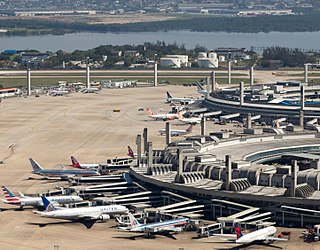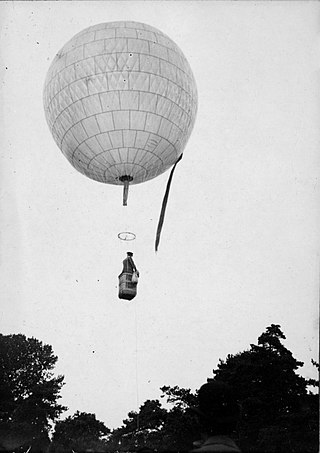
Alberto Santos-Dumont was a Brazilian aeronaut, sportsman, inventor, and one of the few people to have contributed significantly to the early development of both lighter-than-air and heavier-than-air aircraft. The heir of a wealthy family of coffee producers, he dedicated himself to aeronautical study and experimentation in Paris, where he spent most of his adult life. He designed, built, and flew the first powered airships and won the Deutsch Prize in 1901, when he flew around the Eiffel Tower in his airship No. 6, becoming one of the most famous people in the world in the early 20th century.
Viação Aérea São Paulo S/A, better known as VASP, was an airline with its head office in the VASP Building on the grounds of São Paulo–Congonhas Airport in São Paulo, Brazil. It had main bases at São Paulo's two major airports, São Paulo–Congonhas Airport (CGH) and São Paulo/Guarulhos International Airport (GRU).
This is a list of aviation-related events from 1902:

The 14-bis, also known as Oiseau de proie, was a pioneer era, canard-style biplane designed and built by Brazilian aviation pioneer Alberto Santos-Dumont. In 1906, near Paris, the 14-bis made a manned powered flight that was the first to be publicly witnessed by a crowd. It was also the first powered flight made anywhere outside of the United States, as well as the first powered flight by a non-Wright airplane.

São Paulo/Congonhas–Deputado Freitas Nobre Airport[kõˈɡõɲɐs] is one of the four commercial airports serving São Paulo, Brazil. The airport is named after the neighborhood where it is located, called Vila Congonhas, property of the descendants of Lucas Antônio Monteiro de Barros (1767–1851), Viscount of Congonhas do Campo, first president of the Province of São Paulo after the independence of Brazil in 1822, during the Empire. In turn, the Viscount's domain was named after the plural of a shrub known in Brazil as congonha-do-campo. Since June 19, 2017, it is officially named after Deputy José Freitas Nobre. The name Congonhas, however, remains mostly used. It is owned by the City of São Paulo.

Rio de Janeiro/Galeão–Antonio Carlos Jobim International Airport, popularly known by its original name Galeão International Airport, is the main airport serving Rio de Janeiro, Brazil. In 2019, it was the country's fourth-busiest airport by passenger traffic. It is named after the neighborhood of Galeão. Praia do Galeão is located in front of the original passenger terminal and where the galleon Padre Eterno was built in 1663. Since 5 January 1999, it is also named after Brazilian musician Antonio Carlos Jobim. Galeão Airport is explicitly mentioned in his composition Samba do Avião. It is the largest airport site in terms of area in Brazil.

Santos Dumont Airport is the second major airport serving Rio de Janeiro, Brazil. It is named after the Brazilian aviation pioneer Alberto Santos Dumont (1873–1932). It is operated by Infraero.
Avianca Brasil S.A., officially Oceanair Linhas Aéreas S/A, was a Brazilian airline based in Congonhas Airport in São Paulo, Brazil. According to the National Civil Aviation Agency of Brazil (ANAC), which cancelled its operation, prior to cessation of operations, from January to December 2018 Avianca Brasil had 13.4% of the domestic and 7.3% of the international market share in terms of passengers per kilometer flown, making it the fourth-largest airline both in domestic and international traffic in Brazil. The company slots were redistributed by Anac. An auction on 10 July 2019 raised R$555.3 million, not enough to pay a debt of R$2.7 billion, although Avianca's bankruptcy was not officially decreed.

The National Civil Aviation Agency, is the Brazilian civil aviation authority, created in 2005. It is headquartered in the Edifício Parque Cidade Corporate in Brasília. A part of the Brazilian Secretariat of Civil Aviation, the agency raised from the former Department of Civil Aviation (DAC) and the Civil Aviation Certification Division, the Brazilian aircraft certification authority. ANAC is responsible for regulating and overseeing civil aviation activities, aeronautics and aerodromes infrastructure.
RealTransportes Aéreos was a Brazilian airline founded in 1945. It was merged into Varig in 1961, when Varig bought the Consórcio Real-Aerovias-Nacional, of which Real was the main carrier.
Lóide Aéreo Nacional S/A was a Brazilian airline founded in 1947 as Transporte Carga Aérea (TCA). It was renamed Lóide Aéreo Nacional in 1949, after it merged with Linhas Aéreas Paulistas (LAP) and Transportes Aéreos Bandeirantes (TABA). It operated until 1962 when it was incorporated into VASP.

Galeão Air Force Base – ALA11 is a base of the Brazilian Air Force located in Rio de Janeiro, Brazil. It is named after nearby Praia do Galeão, where in 1663 the galleon Padre Eterno was built.
TAC – Empresa de Transportes Aéreos Catarinense S/A was a Brazilian airline founded in 1947 that operated mainly in the south and southeast regions of Brazil. It was absorbed by Cruzeiro do Sul in 1966.
Viação Aérea Santos Dumont, or VASD, was a Brazilian airline founded in 1944. It was bought by and merged into Transportes Aéreos Nacional in 1952.
LAB – Linhas Aéreas Brasileiras S.A. was a Brazilian airline founded in 1945. It ceased operations in 1948.
Brasil Central Linhas Aéreas was a Brazilian airline founded in 1976 as VOTEC Serviços Aéreos Regionais. In 1986 its name was changed to Brasil Central Linhas Aéreas and in 1990 to TAM – Transportes Aéreos Meridionais. In 2000 it was merged into TAM – Transportes Aéreos Regionais, creating TAM Linhas Aéreas.
Henrique Gomes de Paiva Lins de Barros is a Brazilian physicist, biophysicist, writer, science communicator, musician, screenwriter, painter and poet.

Brésil was the first spherical balloon made for Alberto Santos Dumont, in which, at the age of 25, he introduced several innovations in aeronautics and made more than 200 flights.

The Paxairship disaster was the explosion of the Pax airship on May 12, 1902, in Paris, which killed the Brazilian inventor Augusto Severo and the French mechanic Georges Saché.















